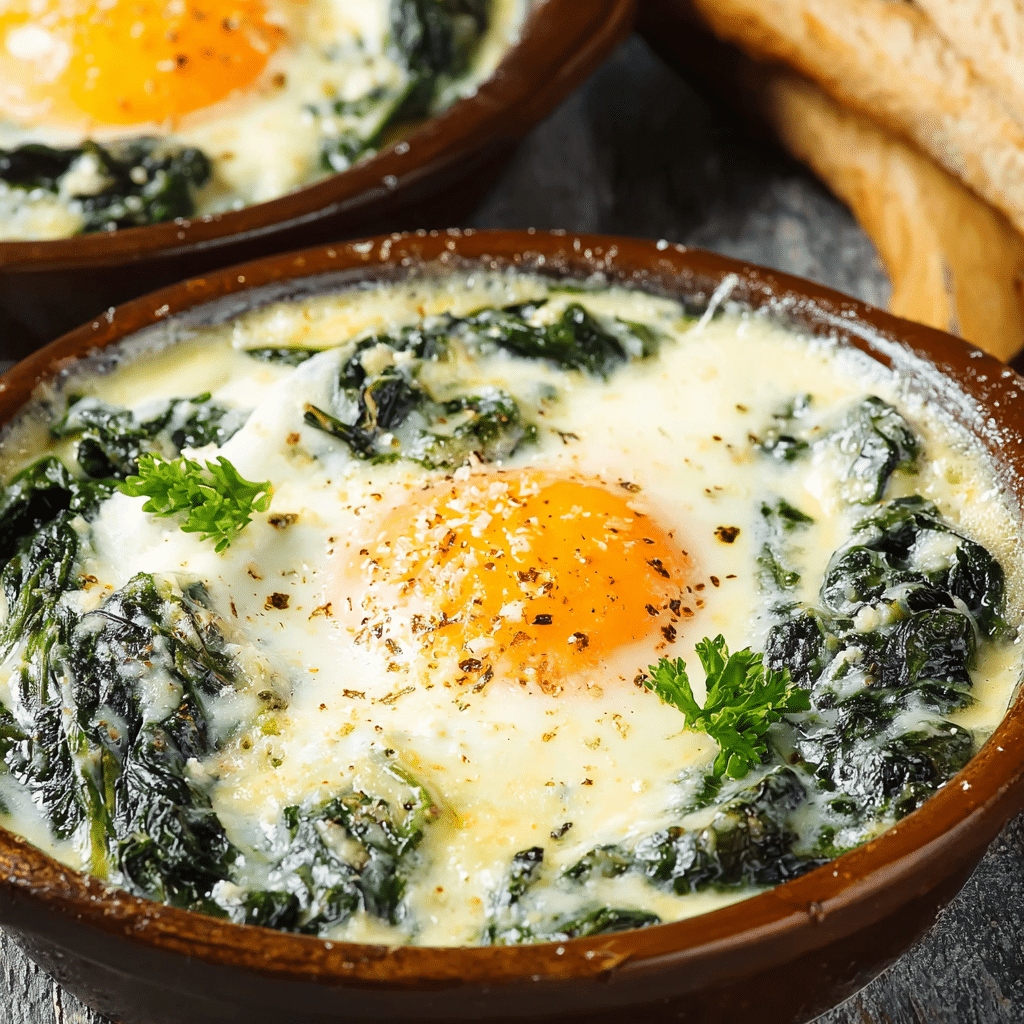The classic elegance of Baked Eggs Florentine never goes out of style. With tender spinach sautéed in garlic and onions, enriched with cream and a hint of nutmeg, this dish wraps your morning in comforting warmth. Each egg bakes to perfection in its own spinach nest, topped with golden, bubbling Parmesan.
Ideal for weekend brunch or a cozy breakfast-for-dinner, these creamy spinach baked eggs are deceptively simple yet impressively flavorful. Serve them with crusty bread or a side salad for a satisfying, wholesome meal that feels like a treat but comes together effortlessly.
Full Recipe
Ingredients:
-
2 tablespoons butter
-
1 small onion, finely chopped
-
2 cloves garlic, minced
-
1 pound (450g) fresh spinach, washed and chopped
-
1/4 cup heavy cream
-
1/4 teaspoon freshly grated nutmeg
-
Salt and pepper, to taste
-
4 large eggs
-
1/4 cup grated Parmesan cheese
-
1 tablespoon chopped fresh parsley (optional)
Directions:
-
Preheat your oven to 375°F (190°C).
-
Melt butter in a large skillet over medium heat. Add the onion and cook until soft and translucent, about 3-4 minutes.
-
Stir in the garlic and cook for another 30 seconds until fragrant.
-
Add the chopped spinach and cook until wilted, about 3-5 minutes.
-
Stir in the cream, nutmeg, salt, and pepper. Cook for 1-2 more minutes, then remove from heat.
-
Spoon the spinach mixture into four greased ramekins or a small baking dish.
-
Make a small well in the center of each portion of spinach and crack an egg into each one.
-
Sprinkle Parmesan cheese evenly over the eggs.
-
Bake for 12-15 minutes, or until the egg whites are set and the yolks are cooked to your liking.
-
Garnish with fresh parsley before serving, if desired.
Prep Time: 10 minutes | Cooking Time: 15 minutes | Total Time: 25 minutes
Kcal: 210 kcal | Servings: 4 servings
The Comforting Origins of Baked Eggs Florentine
Baked Eggs Florentine is a beloved dish that finds its roots in classic French cuisine, though it takes its name from Florence, Italy. The term “Florentine” in culinary usage typically refers to dishes made with spinach, a nod to Catherine de’ Medici, the Florentine noblewoman who married King Henry II of France in the 16th century. As legend goes, Catherine brought her love of spinach with her to the French court, and chefs began creating variations of dishes featuring the leafy green as a base—hence the now-common culinary tag “Florentine.”
This elegant dish blends soft-baked eggs with a bed of creamy, garlicky spinach and a dusting of Parmesan cheese, all baked until the whites are set and the yolks remain just a touch runny. Though its origins are regal, Baked Eggs Florentine is surprisingly humble in ingredients and approachable in preparation, making it a popular choice in modern kitchens, both at home and in cafes around the world.
A Balanced, Nutritious Brunch Favorite
One of the reasons Baked Eggs Florentine continues to grow in popularity is its nutritional profile. It’s a dish that offers a strong balance between protein, healthy fats, fiber, and essential vitamins. Eggs provide a powerhouse of nutrients, including vitamin D, B12, and high-quality protein. Meanwhile, spinach contributes fiber, iron, magnesium, and a substantial dose of vitamins A and C.
This makes Baked Eggs Florentine an excellent breakfast or brunch option for those who are health-conscious but still looking for something satisfying and indulgent. The use of heavy cream and Parmesan adds richness and depth of flavor without overwhelming the dish or turning it into a calorie bomb, especially when served in reasonable portions. It can also be modified to accommodate low-carb, keto, or vegetarian diets with minimal changes.
Ideal for Entertaining or Everyday Meals
Beyond its health benefits, Baked Eggs Florentine is remarkably versatile. It can be baked in individual ramekins for a personalized presentation or in a single baking dish for a more casual, family-style serving. This makes it equally suitable for a quiet weekday breakfast, a lazy weekend brunch, or even a sophisticated starter course for a dinner party.
The visual appeal of the dish is another major bonus. With its vibrant green spinach base, golden baked cheese crust, and bright yolk in the center, Baked Eggs Florentine looks as beautiful as it tastes. A garnish of fresh herbs or a drizzle of chili oil can elevate the presentation even further, adding color and flair with very little effort.
Variations to Suit Every Palate
Although the traditional version of Baked Eggs Florentine is already deeply flavorful, it also serves as a blank canvas for culinary creativity. Some cooks add mushrooms, leeks, or roasted tomatoes to the spinach base for added texture and flavor complexity. Others swap out heavy cream for crème fraîche, sour cream, or even Greek yogurt to lighten the dish or introduce a slight tang.
For those who enjoy a bit of spice, incorporating red pepper flakes, cayenne, or even harissa can transform this gentle dish into something bolder. Cheese lovers may experiment with different varieties, such as Gruyère, goat cheese, or mozzarella, each bringing a distinct character and melt to the dish.
And for a more substantial meal, Baked Eggs Florentine can be served on toasted sourdough, crusty baguette slices, or even inside hollowed bread rolls for an edible vessel with a crunchy edge.
Dietary Adaptations and Allergen Considerations
Baked Eggs Florentine is naturally gluten-free, making it accessible for those with celiac disease or gluten sensitivities. It can also be adapted to fit vegetarian and low-carb lifestyles. If dairy is a concern, plant-based creams and cheeses can be substituted, though results may vary in richness and texture.
Those watching cholesterol or saturated fats can use egg whites instead of whole eggs and opt for lower-fat dairy alternatives. The beauty of this recipe lies in its adaptability—it can be as indulgent or as light as needed, without compromising the essence of the dish.
Culinary Techniques That Make a Difference
The texture and flavor of Baked Eggs Florentine can be enhanced with attention to a few key culinary techniques. For example, properly wilting and draining the spinach ensures a non-watery base. Overcooked spinach can become bitter, so a quick sauté is best, just enough to soften it and blend with aromatics like onion and garlic.
Egg timing is also critical—bake the dish just long enough for the whites to set while keeping the yolks slightly soft. This gives you a luxurious contrast between the creamy spinach and the richness of the yolk. A water bath (bain-marie) can help distribute heat evenly when using ramekins, making it easier to achieve consistent results.
Grating fresh nutmeg into the cream mixture, rather than using pre-ground spice, adds an aromatic warmth that elevates the entire dish. These small details add up to a professional-quality result that’s sure to impress.
When and How to Serve Baked Eggs Florentine
This dish shines brightest at brunch, but it’s far too good to reserve for weekends only. With just a handful of ingredients and a quick cooking time, it can easily be made on a weekday morning or for a satisfying light dinner.
Pair it with a fresh arugula or citrus salad, a light soup, or a crusty piece of toast. A glass of crisp white wine or fresh-squeezed orange juice also makes an ideal accompaniment. For a brunch spread, serve it alongside roasted potatoes, smoked salmon, or fruit compote for a feast that covers sweet and savory.
Cultural and Culinary Influence
While Baked Eggs Florentine began as a continental dish, its principles have been adopted and adapted around the globe. In Middle Eastern cuisine, you might see a similar dish called shakshuka, where eggs are poached in spiced tomato sauce. In the U.K., a “Florentine” version of Eggs Benedict includes a poached egg and sautéed spinach on an English muffin topped with hollandaise sauce.
These cross-cultural adaptations speak to the universality of the egg-and-spinach combination. It’s a pairing that works in virtually every culinary tradition, which is why dishes like Baked Eggs Florentine continue to evolve and appear in new, exciting ways on menus and kitchen tables alike.
Conclusion: A Classic Worth Mastering
Baked Eggs Florentine is one of those rare dishes that feels both luxurious and simple, refined yet accessible. It’s a great recipe for home cooks at any level, and the payoff is enormous in both flavor and presentation. It encourages mindfulness in preparation—using fresh ingredients, perfect timing, and attention to texture—and rewards you with a beautifully balanced dish.
Whether you’re cooking for one, feeding a family, or entertaining guests, Baked Eggs Florentine delivers on all fronts: health, taste, visual appeal, and versatility. Mastering this dish means you’ll always have a dependable recipe in your arsenal—one that satisfies, nourishes, and delights.






